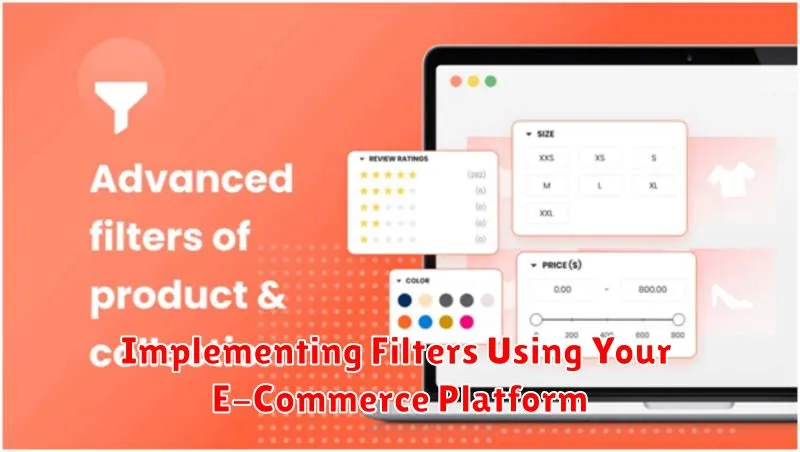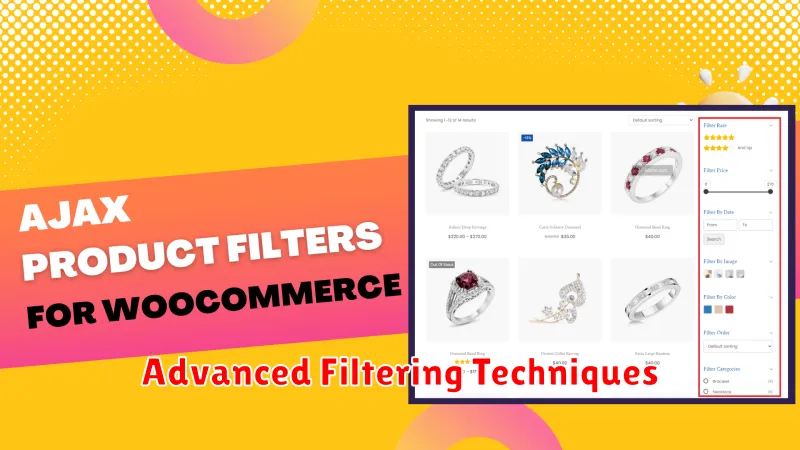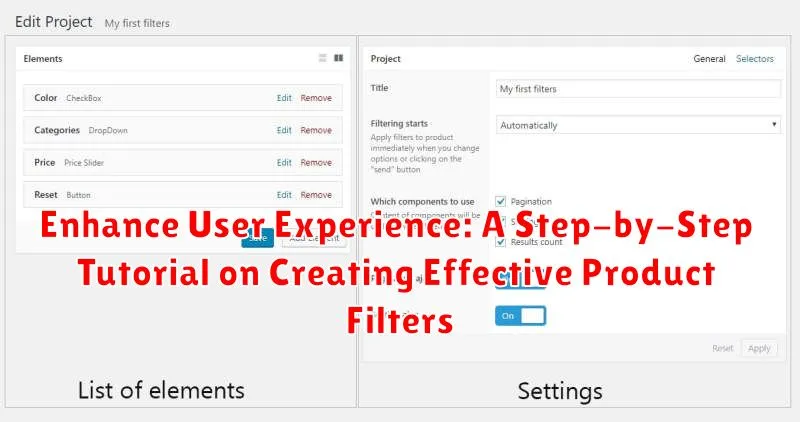In today’s fast-paced digital landscape, providing a seamless and intuitive user experience is paramount to the success of any online product. Users expect to find what they need quickly and efficiently. Product filters play a crucial role in this process, enabling users to refine search results and pinpoint desired items with ease. This step-by-step tutorial will guide you through the process of creating effective product filters that enhance user experience and drive conversions. We will explore best practices for filter design, discuss various filter types, and delve into the technical considerations for implementation. Whether you’re an e-commerce entrepreneur, a web developer, or a UX designer, this guide will equip you with the knowledge to optimize your product filtering system and create a truly user-centric online experience. Mastering the art of product filtering is essential for maximizing user engagement and ultimately, achieving your business objectives.
This tutorial will cover the entire process, from understanding the fundamentals of user experience in relation to product filtering to advanced techniques for creating dynamic and personalized filters. We will examine the importance of filter placement, label clarity, and the strategic use of filter options. By following this comprehensive guide, you will learn how to empower users to effortlessly navigate your product catalog, discover relevant items, and ultimately make informed purchasing decisions. The goal is to create a positive and efficient user journey that transforms casual browsers into satisfied customers. Join us as we unlock the potential of effective product filters and elevate your user experience to new heights.
Understanding the Importance of Product Filters
Product filters play a crucial role in enhancing user experience on e-commerce websites. They empower customers to quickly and efficiently find the products they need, reducing frustration and improving overall satisfaction.
Effective filtering streamlines the browsing experience. Instead of sifting through countless irrelevant products, users can narrow down their search based on specific criteria. This saves time and allows customers to focus on items that genuinely match their needs and preferences.
By providing relevant filters, you increase conversion rates. When users can easily find what they’re looking for, they’re more likely to make a purchase. Filters alleviate the pain points of searching and create a more streamlined path to purchase.
Improved site navigation is another key benefit. Filters facilitate exploration and discovery by allowing users to drill down into specific product categories and subcategories, exposing them to a wider range of relevant offerings.
Planning Your Product Filter Strategy
A well-defined strategy is crucial for effective product filters. This involves careful consideration of your target audience, their needs, and how they interact with your products.
Start by analyzing your product catalog. Identify key attributes that customers might use to search and narrow down results. Consider the variety within each attribute. For example, if you sell clothing, size, color, and material are likely important filters.
Next, think about the user experience. Filters should be intuitive and easy to use. Avoid overwhelming users with too many options. Prioritize the most relevant filters and consider using a layered approach, allowing users to progressively refine their search.
Testing is essential. Gather user feedback to identify any pain points and areas for improvement. Analyze search data and user behavior to understand how customers are using your filters and adjust your strategy accordingly.
Defining Filter Categories and Options
This crucial step involves selecting the right filter categories and options to streamline product discovery. Begin by analyzing your product catalog and identifying key attributes that customers might use to narrow down their searches. Relevance is key; focus on characteristics that truly differentiate your products.
Consider common filter categories like price, size, color, brand, and material. For more specialized products, industry-specific filters become vital. For example, a clothing retailer might offer filters for “sleeve length” or “occasion,” while an electronics store might include filters for “screen size” or “processor type.”
Within each category, provide a logical and comprehensive set of options. Avoid overwhelming users with too many choices; instead, group similar options where appropriate. For instance, instead of listing every individual size, use ranges like “Small (S-M)” or “Large (L-XL).”
User research can provide invaluable insights into which filters are most important to your target audience. Consider conducting surveys or analyzing search queries to understand how customers are looking for products.
Implementing Filters Using Your E-Commerce Platform

This stage heavily relies on your chosen e-commerce platform. Most platforms offer built-in filtering functionalities, while others may require third-party plugins or custom development. Understanding your platform’s capabilities is crucial for a smooth implementation.
Built-in Filtering: If your platform provides native filtering, explore its configuration options. Typically, you can select which attributes (e.g., size, color, price) are filterable and customize their presentation.
Plugins and Extensions: Numerous plugins and extensions exist to enhance filtering capabilities. Research reputable options compatible with your platform and assess their features, reviews, and support.
Custom Development: For highly specialized filtering requirements, custom development might be necessary. This offers maximum flexibility but involves more technical expertise and resources.
Regardless of your chosen method, thorough testing is essential. Test all filters across various devices and browsers to ensure accurate functionality and a seamless user experience.
Best Practices for Product Filter Design
Effective product filters are crucial for a positive user experience. Here are some best practices to consider:
Placement and Visibility
Prioritize clear visibility. Place filters where users expect to find them, typically in the left sidebar or horizontally above product listings. Avoid hiding filters behind menus or requiring extra clicks. Filters should be readily accessible.
User Interface and Interaction
Ensure a smooth, intuitive filtering process. Use clear labels for filter categories and options. Provide instantaneous feedback as users select filters, updating the product display without page reloads. Consider incorporating visual cues, such as checkmarks or color changes, to indicate active filters.
Filter Logic and Options
Offer a logical filter structure that reflects how users think about product categories. Provide a relevant range of filtering options based on your product catalog. Avoid overwhelming users with too many options. Consider a hierarchical structure for complex categories.
Testing and Optimizing Your Filters
After implementing your product filters, rigorous testing is crucial. Usability testing with real users provides invaluable insights into filter effectiveness and identifies potential pain points. Observe how users interact with the filters, noting any difficulties they encounter in finding desired products.
A/B testing allows you to compare different filter designs and configurations. Test variations in filter placement, labeling, and functionality. Track key metrics like conversion rates, average order value, and time spent on site to determine which version performs best.
Analyze user behavior data collected through analytics platforms. Identify popular filter options and search queries. This data helps you optimize filter options and prioritize the most relevant criteria for your users. Regularly review and refine your filters based on this data to ensure they remain effective and aligned with user needs.
Using Faceted Navigation to Enhance UX
Faceted navigation, also known as faceted search, dramatically improves user experience by allowing users to refine product searches based on multiple criteria simultaneously. This dynamic filtering system presents users with a range of filter options, organized by facets or attributes relevant to the product catalog.
Key benefits of using faceted navigation include reduced search time and effort, a more intuitive browsing experience, and increased product discovery. By presenting filters as interactive facets, users can quickly narrow down results and find precisely what they’re looking for. For example, a user searching for shoes could filter by size, color, brand, style, and price all at once, rather than performing separate searches for each attribute.
Faceted navigation provides immediate feedback to user selections, dynamically updating the product listing as filters are applied. This real-time interaction allows users to understand the impact of their choices and fine-tune their search progressively.
Mobile Optimization for Product Filters
Mobile optimization is crucial for product filters due to smaller screen sizes and different user interactions. Prioritize a clean and uncluttered interface.
Consider using a collapsible filter menu. This approach keeps the screen clear until the user actively chooses to interact with the filtering options. When activated, the menu should provide a comprehensive yet easy-to-navigate list of filter choices.
Input methods must be adapted for touchscreens. Steppers and sliders work well for numerical ranges (like price), while large checkboxes and radio buttons improve selection accuracy. Avoid small, fiddly controls.
Limit the initial filter options displayed. “Load more” buttons or infinite scrolling can reveal additional choices as needed, preventing overwhelming users with too many options at once.
Advanced Filtering Techniques

Beyond basic filtering, advanced techniques can significantly improve user experience and streamline product discovery. Consider implementing these strategies to cater to users with specific needs and preferences.
Dynamic Filtering
Dynamic filtering adjusts available filter options based on current selections. This prevents users from encountering zero-results pages and guides them towards relevant products. For example, if a user selects “blue” in the color filter, the size filter would only display sizes available in blue.
Price Range Sliders
Instead of predefined price brackets, implement sliders that allow users to specify a custom price range. This offers more flexibility and control over budget limitations.
Keyword-Based Filtering
Allow users to search within filter categories using keywords. This is particularly useful for categories with numerous options, like “brand” or “material.”
Visual Filtering
For certain product types, visual filters can enhance the experience. Consider color swatches for clothing or shape filters for jewelry.

